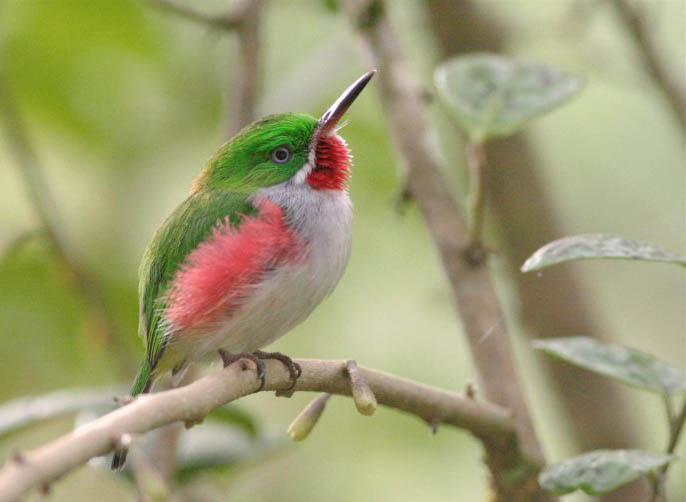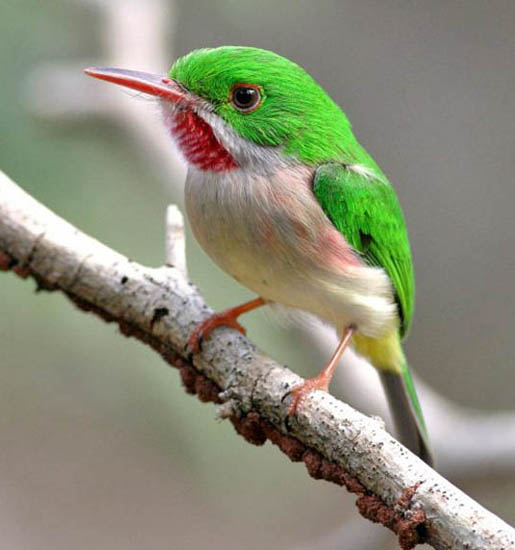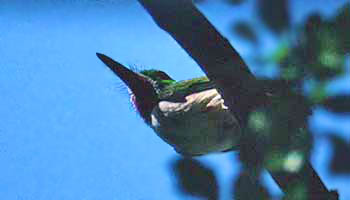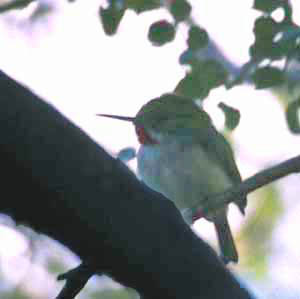| |
TODIES Todidae |
- 5 species on Caribbean islands
- DR personal total: 3 species (60%), 2 photo'd
|
 The Todidae is a family that is endemic to Caribbean islands. Five species todies, all in genus Todus,
reside on four islands: Jamaica, Cuba, Hispaniola, and Puerto Rico.
They are just great little birds — not much larger than hummingbirds —
that suddenly appear next to the observer inside woodlands. The color
scheme is so dramatic — especially if the pink flank plumes can be seen
— that they recall a toy. Murray Lord captured this well in his shot of
Narrow-billed Tody (left) in the Dominican Republic. The Todidae is a family that is endemic to Caribbean islands. Five species todies, all in genus Todus,
reside on four islands: Jamaica, Cuba, Hispaniola, and Puerto Rico.
They are just great little birds — not much larger than hummingbirds —
that suddenly appear next to the observer inside woodlands. The color
scheme is so dramatic — especially if the pink flank plumes can be seen
— that they recall a toy. Murray Lord captured this well in his shot of
Narrow-billed Tody (left) in the Dominican Republic.
Todies
sit quietly, scanning the undersides of foliage, then dash out to snap
something up and return to their perch. Most often they are first
located by voice, and most birds seemed to be in pairs. |
 The one island with two todies is Hispaniola, where Narrow-billed Tody (shown above) inhabits montane forests, and Broad-billed Tody Todus subulatus
occurs in the lowlands (right, in another impressive photo by Murray
Lord). The two species are outwardly quite similar until one can see
the width of the bill, as in this shot of Broad-billed Tody (below). The one island with two todies is Hispaniola, where Narrow-billed Tody (shown above) inhabits montane forests, and Broad-billed Tody Todus subulatus
occurs in the lowlands (right, in another impressive photo by Murray
Lord). The two species are outwardly quite similar until one can see
the width of the bill, as in this shot of Broad-billed Tody (below).

Not
only are todies remarkably colorful, but they tend to puff out their
crimson throat patches each time they call, endearing them to the
observer. |
 The Puerto Rican Tody (left) is restricted to dry thornscrub forest on Puerto Rico. Its latin name — Todus mexicanus
—comes from a mistake on the label of the type specimen. Todies are not
particularly shy but I found them tough to photograph — at least back
in pre-digital days —as they tended to stay in the shade. The Puerto Rican Tody (left) is restricted to dry thornscrub forest on Puerto Rico. Its latin name — Todus mexicanus
—comes from a mistake on the label of the type specimen. Todies are not
particularly shy but I found them tough to photograph — at least back
in pre-digital days —as they tended to stay in the shade.
Todies
are usually considered to be most closely related to motmots. The most
recent molecular analysis suggests that they diverged from the
ancestors that led to motmots and kingfishers abut 40 million years ago
(Prum et al. 2015). They have been isolated in the Caribbean for a long
long time. Yet there are fossils in Switzerland which suggest that the
ancestors of motmots and todies were once more widespread, and not just
restricted to the Neotropics (Kepler 2001). |
| |
Photos: Murray Lord photographed the Narrow-billed Tody Todus angustirostris in the Dominican Republic on 26 Apr 2009, and his Broad-billed Tody T. subulatus
was photographed on that same visit, on 27 Apr 2009. My photo of
Broad-billed Tody was in Jan 1999 in Santo Domingo's botanical garden.
The Puerto Rican Tody T. mexicanus was at Guanica Reserve, Puerto Rico, in Jan 1999
Uncredited photos © Don Roberson. Credited photos © Murray Lord, as credited, and used with permission; all rights reserved.
Bibliographic note: There is no "family book" per se but a fine introduction to this family, with good photos, is in Kepler (2001).
Literature cited:
Kepler, A.K. 2001. Family Todidae (Todies), pp. 250–263 in Handbook of the Birds of the World (del Hoyo, J., A. Elliott & J. Sargatal, eds). Vol. 6. Lynx Edicions, Barcelona, Spain.
Prum,
R.O., J.S. Bery, A. Dornburg, D.J. Field, J.P. Townsend, E.M. Lemmon,
and A.R. Lemmon. 2015. A comprehensive phylogeny of birds (Aves) using
targeted next-generation DNA sequencing. Nature 526: 569–573.
|
|
|

 The Todidae is a family that is endemic to Caribbean islands. Five species todies, all in genus Todus,
reside on four islands: Jamaica, Cuba, Hispaniola, and Puerto Rico.
They are just great little birds — not much larger than hummingbirds —
that suddenly appear next to the observer inside woodlands. The color
scheme is so dramatic — especially if the pink flank plumes can be seen
— that they recall a toy. Murray Lord captured this well in his shot of
Narrow-billed Tody (left) in the Dominican Republic.
The Todidae is a family that is endemic to Caribbean islands. Five species todies, all in genus Todus,
reside on four islands: Jamaica, Cuba, Hispaniola, and Puerto Rico.
They are just great little birds — not much larger than hummingbirds —
that suddenly appear next to the observer inside woodlands. The color
scheme is so dramatic — especially if the pink flank plumes can be seen
— that they recall a toy. Murray Lord captured this well in his shot of
Narrow-billed Tody (left) in the Dominican Republic.  The one island with two todies is Hispaniola, where Narrow-billed Tody (shown above) inhabits montane forests, and Broad-billed Tody Todus subulatus
occurs in the lowlands (right, in another impressive photo by Murray
Lord). The two species are outwardly quite similar until one can see
the width of the bill, as in this shot of Broad-billed Tody (below).
The one island with two todies is Hispaniola, where Narrow-billed Tody (shown above) inhabits montane forests, and Broad-billed Tody Todus subulatus
occurs in the lowlands (right, in another impressive photo by Murray
Lord). The two species are outwardly quite similar until one can see
the width of the bill, as in this shot of Broad-billed Tody (below).
 The Puerto Rican Tody (left) is restricted to dry thornscrub forest on Puerto Rico. Its latin name — Todus mexicanus
—comes from a mistake on the label of the type specimen. Todies are not
particularly shy but I found them tough to photograph — at least back
in pre-digital days —as they tended to stay in the shade.
The Puerto Rican Tody (left) is restricted to dry thornscrub forest on Puerto Rico. Its latin name — Todus mexicanus
—comes from a mistake on the label of the type specimen. Todies are not
particularly shy but I found them tough to photograph — at least back
in pre-digital days —as they tended to stay in the shade.